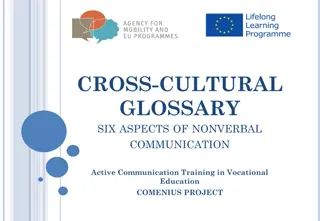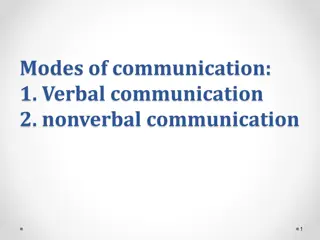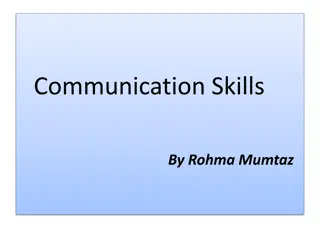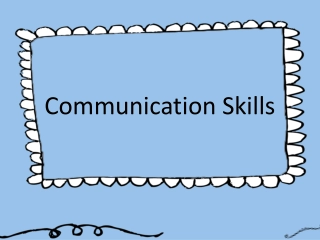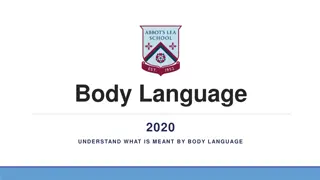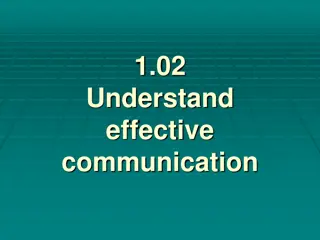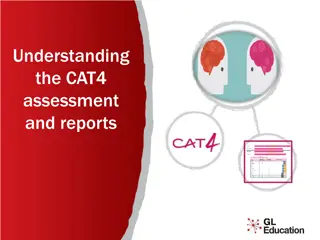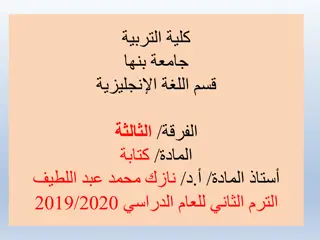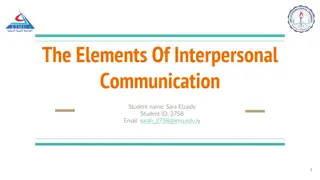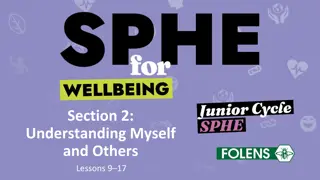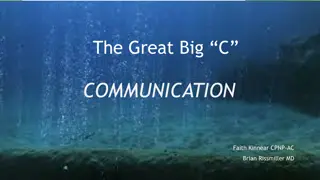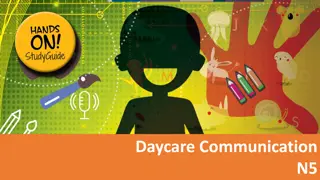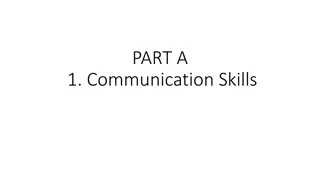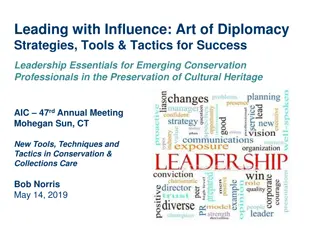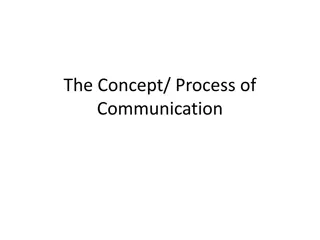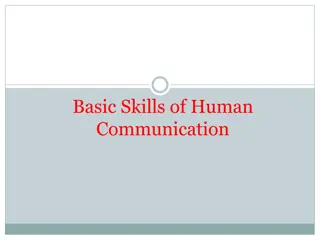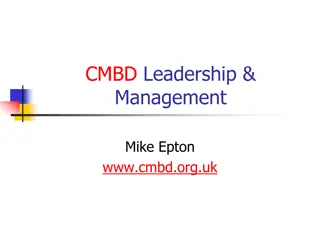Mastering Nonverbal and Verbal Communication for Effective Leadership
Discover the crucial X and Y factors of nonverbal and verbal communication for leaders through active listening, message delivery, and nonverbal cues. Explore how poor communication leads to stress and learn techniques like reflective styles, Socratic questioning, and giving concise messages. Enhance your communication skills with practical strategies shared by Dr. John White.
Download Presentation

Please find below an Image/Link to download the presentation.
The content on the website is provided AS IS for your information and personal use only. It may not be sold, licensed, or shared on other websites without obtaining consent from the author. Download presentation by click this link. If you encounter any issues during the download, it is possible that the publisher has removed the file from their server.
E N D
Presentation Transcript
THE X AND Y FACTORS NONVERBAL AND VERBAL COMMUNICATION FOR LEADERS Dr John White
FRAMES OF MY TALK TODAY: Active listening (X and Y Factors) Giving messages and getting the point across (Y Factor) Nonverbal Communication ( X Factor)
HOW v WHAT POOR COMMUNICATION CAUSES STRESS
ACTIVE LISTENING 1. Speakers want listeners to respond appropriately to what they are saying, rather than just listen (Halone and Pecchioni, 2001, 63) 2. Verbal Following 3. Match verbal responses closely to those of the speaker 4. Ask related questions 5. Make related statements that build on the ideas expressed 6. Reference to past statements 7. Eg details / facts / emotions
ACTIVE LISTENING 1. Use of probing questions 2. Open v closed questions did this upset you? v how did you feel about this? 3. Verbal door openers (Kramer, 2001) would you like to talk about that a bit more? 4. Predictive Styles (Turkat and Alpher, 1984) predicting based on information gleaned 5. Verbal reinforcers - need to give a reason for the comments
CARL ROGERS - REFLECTIONS (PARAPHRASING WITH EMOTIONAL VALUE) statements in the interviewer's own words that encapsulate and re-present the essence of the interviewee s previous message (Hargie and Dickson, 2004, 148)
REFLECTIVE STYLE 1. Use your own words 2. Do not go beyond the information communicated by the addressee 3. Be concise don t say everything that is said specific - concrete 4. Be accurate the inclusion of a check-out statement deep down I sense a feeling of relief, would you agree? 5. Combining facts and feelings reflections combine reflections of feelings and paraphrasing
Y FACTOR - SOCRATIC QUESTIONING Answer a question with another question ! Y? It provides an active role in the learning process
Y FACTOR GIVING MESSAGES Concision - an explanation / message with more detail than necessary is just as defective as one with inadequate material (Ruben, 1990) growing fat on information but starved for knowledge (Clampit, 2001, 71) Memory Recall 15 minutes ! Learning begins to diminish seriously after 15 minutes (Verner and Dickson, 1967, 90)
Y FACTOR GIVING MESSAGES: CLARITY ABOUT WHAT YOU SAY (BROWN AND ATKINS, 1997) 1. Provide signposts set out structure of the presentation / what you want to say Provide Markers: eg first, second, third fundamental finally major Mnemonics: eg fabulous fascinating; amazing; bountiful; Provide frames 1. setting the boundaries of the topic to be discussed 2. words or phrases that show what will and if necessary what will not be covered Provide foci key statements during presentation / talk that stand out Plan repetition 2. 3. 4. 5.
PERSUASION SOME KEY POINTERS Stress a lack of personal bias Ask audience to keep an open mind Emphasise that both sides of argument have been given consideration State that the targets best interests are in mind Conclusions: Cruz the more explicit the conclusions to a persuasive message, the better the conclusion is comprehended (Cruz, 1998)
FIRST IMPRESSIONS HORNS OR HALO? First impressions Horns or Halo? (Adler et al., 2001) People form impressions and judgements and then we tend to adapt any conflicting information to make it fit in more easily with the first impression
THE LISTENING SCHOOL The Listening Leader !
LEAKAGE nonverbal communication can be seen as more truthful through the insights that it affords into what may lie behind the verbal messages
EMOTIONAL CONTAGION EFFECT How good are you?
SOCIAL FACILITATION EFFECT Performance is enhanced by presence of others looking !! How good are you?
PROXEMICS - LEANING AND BODY ORIENTATION We lean more towards people when we are interested in what they are saying Body directly oriented towards the person Distance one maintains with a speaker Moving closer to people we like
SMILING Power of smiling induced in others real and fake smiles How good are you?
SELF-AUDIT HOW DO YOU PERCEIVE YOURSELF AS A COMMUNICATOR? In pairs / individually, complete the worksheet and answer honestly how well you think you communicate. Samples of questions: I move away from others when they touch me while we are talking. I have a relaxed body position when I talk to people. I frown while talking to people. I avoid eye contact while talking to people. I have a tense body position while talking to people.
EYE CONTACT Differentiated eye contact Favoured people when asking a question / seeking feedback Reluctant participants involvement of people Maintaining eye contact people we like / don t like Location of eye contact We look more at people we are growing to like Backchannel responses head nodding Grounding Eyes closed How good are you?
GESTURE Open palms Providing additional meaning Reinforcement People who gesture are seen as more likeable
BODY MOVEMENTS Ballet dancers! Jerky movements Smooth movements
BODY LANGUAGE Open and closed Arms Body orientation Trunk
Voice Intonation I m Happy !!
Voice Intonation I m Happy !! In accordance with Darwin s hypothesis on the origins of language, extensive research has identified a positive effect of emotional stimuli on cognition, particularly on attentional, perceptual, and memory resources (Dolan 2002; Kotz and Paulmann 2011; Storbeck and Clore 2008).
VOICE leakier channel than the face Verbal fluency people are fluent when they know what they are talking about persuasiveness Breathing effects voice Tightened lips - doody Loud voices = dominance Faster rates of speech correlate with lower perceptions of dominance Attractive Voices people are perceived as competent, industrious, sensitive, warm and dominant Resonance Not monotone Not nasal
FACIAL EXPRESSIONS Lighthouse of emotion Can be differentiated Affect blends Over-intensification effect






